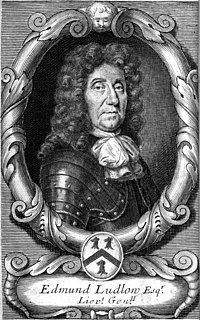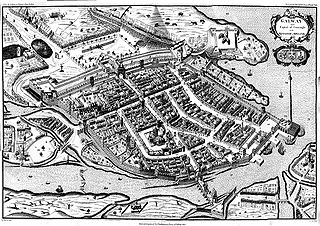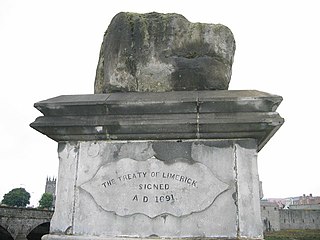This article does not cite any sources .(February 2015) (Learn how and when to remove this template message) |
| |||||
| Centuries: | |||||
|---|---|---|---|---|---|
| Decades: | |||||
| See also: | Other events of 1651 List of years in Ireland | ||||
Events from the year 1651 in Ireland.
This article does not cite any sources .(February 2015) (Learn how and when to remove this template message) |
| |||||
| Centuries: | |||||
|---|---|---|---|---|---|
| Decades: | |||||
| See also: | Other events of 1651 List of years in Ireland | ||||
Events from the year 1651 in Ireland.

Edmund Ludlow was an English parliamentarian, best known for his involvement in the execution of Charles I, and for his Memoirs, which were published posthumously in a rewritten form and which have become a major source for historians of the Wars of the Three Kingdoms. After service in the English Civil Wars, Ludlow was elected a Member of the Long Parliament. After the establishment of the Commonwealth in 1649 he was made second-in-command of Parliament's forces in Ireland, before breaking with Oliver Cromwell over the establishment of the Protectorate. After the Restoration Ludlow went into exile in Switzerland, where he spent much of the rest of his life. Ludlow himself spelled his name Ludlowe.

Henry Ireton was an English general in the Parliamentary army during the English Civil War, the son-in-law of Oliver Cromwell.

Limerick, in western Ireland was the scene of two sieges during the Irish Confederate Wars. The second and largest of these took place during the Cromwellian conquest of Ireland in 1650–51. Limerick was one of the last fortified cities held by an alliance of Irish Confederate Catholics and English Royalists against the forces of the English Parliament. Its garrison, led by Hugh Dubh O'Neill, surrendered to Henry Ireton after a protracted and bitter siege. Over 2,000 soldiers of Cromwell's New Model Army were killed at Limerick, and Henry Ireton, Cromwell's son-in-law died of plague.
This section is empty.You can help by adding to it.(February 2013) |
October 31 is the 304th day of the year in the Gregorian calendar. 61 days remain until the end of the year.
The Bishop of Emly was a separate episcopal title which took its name after the village of Emly in County Tipperary, Republic of Ireland. In both the Church of Ireland and the Roman Catholic Church, it has been united with other sees.
Events from the year 1600 in Ireland.

The Irish Confederate Wars, also called the Eleven Years' War, took place in Ireland between 1641 and 1653. It was the Irish theatre of the Wars of the Three Kingdoms – a series of civil wars in the kingdoms of Ireland, England and Scotland. The war in Ireland began with a rebellion in 1641 by Irish Catholics, who tried to seize control of the English administration in Ireland to force concessions for Catholics. This developed into an ethnic conflict between Gaelic Irish and old English Catholics on one side, and English and Scottish Protestant colonists on the other. Catholic leaders formed the Irish Catholic Confederation in 1642, which controlled most of Ireland and was loosely aligned with the Royalists. The Confederates and Royalists fought against the English Parliamentarians and Scottish Covenanters. In 1649, a Parliamentarian army led by Oliver Cromwell invaded Ireland and by 1653 had conquered the island.
The Committee of Safety, established by the Parliamentarians in July 1642, was the first of a number of successive committees set up to oversee the English Civil War against King Charles I, and the Interregnum.

The Cromwellian conquest of Ireland or Cromwellian war in Ireland (1649–53) refers to the conquest of Ireland by the forces of the English Parliament, led by Oliver Cromwell, during the Wars of the Three Kingdoms. Cromwell invaded Ireland with his New Model Army on behalf of England's Rump Parliament in August 1649.
Hugh Dubh O'Neill, 5th Earl of Tyrone (1611–1660) was an Irish soldier of the 17th century. He is best known for his participation in the Irish Confederate Wars and in particular his defence of Clonmel in 1650.
The battle of Knocknaclashy, took place in County Cork in southern Ireland in 1651. In it, an Irish Confederate force led by Donagh MacCarthy, Viscount Muskerry was defeated by an English Parliamentarian force under Roger Boyle, 1st Earl of Orrery. It was the final pitched battle of the Irish Confederate Wars and one of the last of the Wars of the Three Kingdoms.

Duncannon is a village in southwest County Wexford, Ireland. Bordered to the west by Waterford harbour and sitting on a rocky headland jutting into the channel is the strategically prominent Duncannon Fort which dominates the village.

Colonel Daniel Axtell was captain of the Parliamentary Guard at the trial of King Charles I at Westminster Hall in 1649. Shortly after the Restoration he was hanged, drawn and quartered as a regicide. Apart from his participation in the regicide, he is best remembered for his participation in Pride's Purge of the Long Parliament.

The city of Waterford in south eastern Ireland was besieged from 1649–50 during the Cromwellian conquest of Ireland. The town was held by Irish Confederate Catholic under General Richard Farrell and English Royalist troops under general Thomas Preston. It was besieged by English Parliamentarians under Oliver Cromwell, Michael Jones and Henry Ireton.

The Siege of Galway took place from August 1651 to May 1652 during the Cromwellian conquest of Ireland. Galway was the last city held by Irish Catholic forces in Ireland and its fall signalled the end to most organised resistance to the Parliamentarian conquest of the country.

Limerick, a city in western Ireland, was besieged twice in the Williamite War in Ireland, 1689-1691. On the first of these occasions, in August to September 1690, its Jacobite defenders retreated to the city after their defeat at the Battle of the Boyne. The Williamites, under William III, tried to take Limerick by storm, but were driven off and had to retire into their winter quarters.

The Siege of Limerick in western Ireland was a second siege of the town during the Williamite War in Ireland (1689–91). The city, held by Jacobite forces was able to beat off a Williamite assault in 1690. However, after a second siege in August – October 1691, it surrendered on favourable terms.
Terence Albert O'Brien was an Irish Roman Catholic Bishop of Emly. He was beatified among the Seventeen Irish Martyrs by Pope John Paul II on 27 September 1992.
Events from the year 1650 in Ireland.
Events from the year 1652 in Ireland.
Events from the year 1565 in Ireland.
Presented below is a chronology of the major events of the Irish Confederate Wars from 1641-1653. This conflict is also known as the Eleven Years War. The conflict began with the Irish Rebellion of 1641 and ended with the Cromwellian conquest of Ireland (1649–53).
Geoffrey Baron was an Irish rebel.